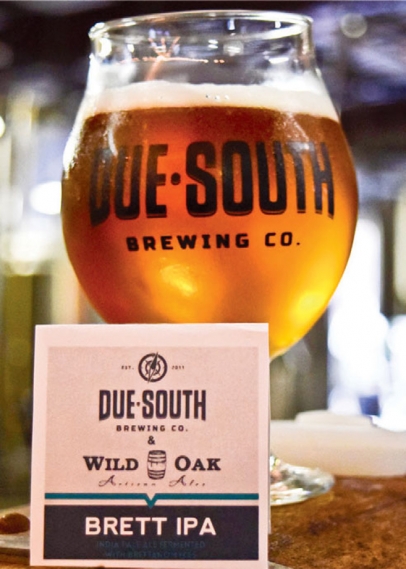Take a Quaff on the Wild Side
A brewer's job, says the beer community, is 90 percent cleaning—brewing requires constant attention to the cleanliness of anything that touches the beer.
But beer has been around for thousands of years without high-tech sterilization techniques. Long before today’s tidy era of beer, wild ales reigned supreme. Yeast and bacteria live all around us. It’s the brewer’s job to give them something to eat and get the right microorganisms into the beer that will convert sugars to alcohol, creating the flavors they’re seeking. During ancient Egyptian times, brewers kept their own ceramic vessels with them as they moved or traveled from place to place. Like the seasoning in a cast iron skillet, the yeasts they had cultivated naturally lived in the crevices of the vessels. Brewers knew if they put the right liquid in this vessel, it would ferment and create beer. While it might have appeared as magic or a gift from the gods, these vessels turned out to be a consistent source of yeast.
BELGIAN BREWERS
For centuries, Belgian breweries have utilized the wild yeast and bacteria in the air to inoculate their wort (unfermented beer). Many farmers also brewed beer for their own family’s consumption, which is why many of these styles are considered farmhouse ales. Farmers would brew beer in the day and let it cool overnight open to the elements, often surrounded by fruit trees. Here, the right yeasts and bacteria that lived on skins of the fruit and on the trees settled into the wort as it cooled and started fermentation. Some, like the farmhouse ales and saisons, are drunk shortly after fermentation, while others go through additional processes. For example, traditional lambics are aged in wood vessels. Over time, the wild organisms (Lactobacillus and Pediococcus) transform the beer and slowly eat up the sugars that yeasts can’t. They also create lactic acids and make the beers sour. These sour beers are then blended in a variety of different ways – some with fruit, sweetened to create different fruit beers, like a kriek (cherry) or framboise (raspberry). Others are blended with younger beers and enjoyed completely tart like the traditional Gueuze.
Lindemans, Timmermans and Cantillon still create these remarkable beers using traditional methods. Highly regarded by beer fanatics, these Belgian beers are seeing a resurgence in the beer community.
It didn’t stop in Belgium, though.
American craft breweries have embraced these bugs, an affectionate term used for the wild yeasts and bacteria. Of course, these bugs can cause heartbreak for a brewery who doesn’t want them to get into their beer and cause an infection that leads them to dump the beer down the drain. But for those special few brewers who seek them out, they can create some exciting neo-Belgian beers. Cascade Brewing in Oregon heavily uses these wild yeasts, barrel aging and fruit additions to create complex beers that age beautifully. Although they’re more expensive than your average six-pack (a 750ml bottle can retail for $30), countless man-hours go into each bottle. Allagash Brewing Company of Portland, Maine, also brews an impressive variety of beers using traditional Belgian open-air fermentation. In Michigan, Jolly Pumpkin Artisan Ales has made a name for itself brewing wildly distinctive beers.
In Florida, Saint Somewhere of Tarpon Springs prides itself on creating traditional farmhouse ales with a Florida spin, using the wild yeasts of the area. Highly carbonated from the continued work of the yeasts in the bottle, these beers feature a beautiful balance of spice and funkiness that works well with food.
U.S. INNOVATION
American craft breweries have embraced a wild yeast named Brettanomyces – Brett – to create new exciting brews. This yeast, which makes wine makers cringe, is an extremely resilient, Dr.-Jekyll-and-Mr.-Hyde type of microorganism, that can’t be completely controlled. But Brett can be worked with delicately to greatly influence a beer, imparting flavors that range from funky-pepperiness, lemons, balsamic vinegar and “horseblanket” to less appealing flavors of blue cheese, Band-Aids and socks.
Crooked Stave of Denver is known for bringing out the Dr. Jekyll of this yeast, creating beautifully crafted saisons and even wild IPAs with it. Victory Brewery has used the yeast to make Wild Devil, a wild version of their Hop Devil, imparting delightful dry funkiness (in a good way) to their hopped-up IPA. Stone Brewing has released their “Enjoy After IPA” in a handful of markets, using this yeast to accentuate their hops. This beer is meant to age for a year after bottling to allow the yeast to evolve the beer and carbonate it over time. Due South Brewing Co. of Boynton Beach recently released a collaboration wild fermented IPA with Wild Oak Artisan Ales, a new brewery opening soon in Boynton Beach that will specialize in these types of wild beers. At Green Bench Brewing Company in St. Petersburg, they utilize a traditional Belgian foeder, a large wooden fermenter where wild yeast live within the grains of the wood and impart distinctive flavors into a handful of their beers. Florida’s Tequesta Brewing has also experimented with a limited amount of barrel-aging with wild yeast.
Every wild beer – each bottle – is unique because they continually change over time, which is part of their charm. The beer is a living thing, bringing signature flavors that you might only experience once. Are you ready to embrace the wild?
{ Winter Beer Happenings }
Jan. 17-24 South Florida Beer Week
southfloridabeerweek.com
Jan. 24 Jupiter Craft Brewers Festival
jupitercraftbrewersfestival.com
Jan. 31 Miami Beer Festival
miamibeerfestival.com
April 15 Veritage Craft Beer Tasting
Veritagemiami.com






